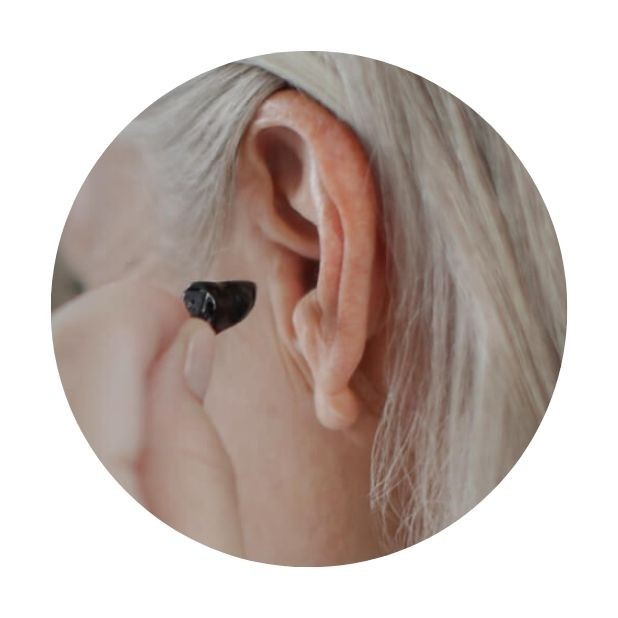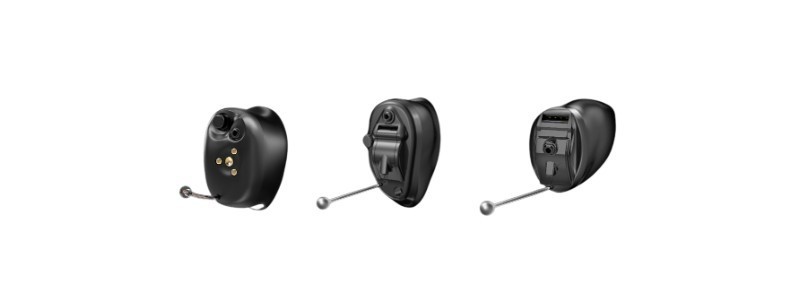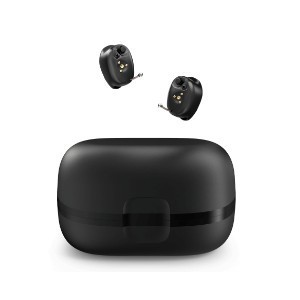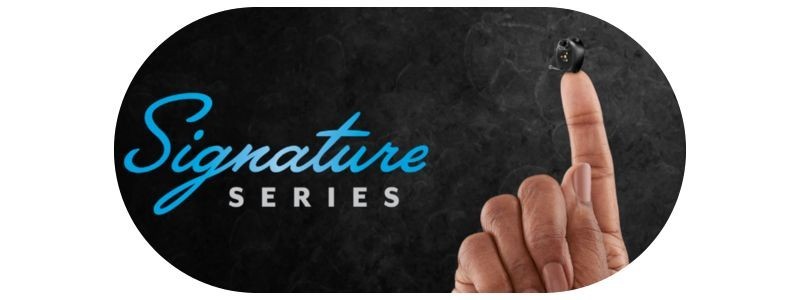Free home visits
with a local audiologist

Everybody wants to listen attentively to their family, friends, and the world around them clearly. However, not everyone feels at ease openly acknowledging their hearing loss.
Powered by the Genesis AI platform (plus some enhancements), with the Starkey Signature Series hearing aid range, you can benefit from both.
Receiving crystal-clear, natural sound through advanced technology that seamlessly conceals within your ear, you can now enjoy...
The invisibility: These hearing aids are virtually invisible; they sit comfortably inside your ear, so no one knows you're wearing them.
Natural sound: Neuro Sound Technology delivers sound similar to the brain's intention, so it remains clear and as natural as possible.
A snug fit: Choose from three custom-fit hearing aids that are bespoke fit to your ear shape and hearing loss.

Signature Series hearing aids are the 2nd generation of Genesis AI, with the addition of motion-based optimisation and automated Edge Mode+; they are Starkey's smallest devices yet.
Launched in three non-wireless custom models (including a rechargeable CIC) and features Neuro Sound Technology.
Each model is IP68 rated, which means they are protected against moisture and debris.
They also offer Starkey's proven tinnitus technology and some impressive wearing times (more on model specifics further down the page).
In regard to the colours available, the CIC models come in six faceplate colours and five shell colours, whilst the IIC comes in six faceplate colours and one shell colour.
This should mean there will be a style suited to most hearing loss levels and hearing needs.
Your audiologist will go through each style, the features, the benefits, and whether this range is the right fit for you.

Starkey has stated that the Completely in the Canal (CIC) NW stands as the world's tiniest custom rechargeable hearing aid. This exceptionally discreet, rechargeable solution has been a long-awaited need for both consumers and professionals.
With the ability to operate for up to 38 hours before needing a recharge, the new CIC R NW aligns with the waterproof standard (IP68 rating) seen in the other Genesis AI rechargeable products.
Faceplate colours available: Black, dark brown, chestnut, medium brown, light brown, and pink.
Shell colours available: Clear, medium brown, light brown, blue/red, and black.
Compatible chargers: Starlink premium charger 2.0 or the Starlink charger 2.0.
Created for those seeking a subtle design, this non-wireless Completely-in-Canal (CIC) option utilises a size 10 battery. With an estimated lifespan of up to 6 days with 16 hours of daily wear, it offers convenient usage without frequent battery changes.
Faceplate colours available: Black, dark brown, chestnut, medium brown, light brown, and pink.
Shell colours available: Clear, medium brown, light brown, blue/red, and black.
According to Starkey, the new Signature Series Invisible in the Canal (IIC) NW outperforms any other small hearing aid available. Catering to those who are conscious about size and social perception, this innovative IIC model uses a size 10 disposable battery.
Offering an impressive lifespan of up to 7 days, using 16 hours of daily wear before requiring a change.
Faceplate colours available: Black, dark brown, chestnut, medium brown, light brown, and pink.
Shell colours available: Black.

Genesis AI featured a complete redesign, inside and out, including all-new hardware and an innovative chip known as the Starkey Neuro Processor. This chip powers the Signature Series, too. Giving you 80 million adjustments per hour and a 20 dB improvement in dynamic range.
The inclusion of this chip marks Starkey's embrace of Deep Neural Network (DNN) technology, which offers advanced learning capabilities for enhanced sound processing built into the hearing aid.
The Neuro Processor is the industry’s most advanced processor with speeds four times faster than previous processors and features six times more transistors, allowing it to adapt to more situations than ever before.

Firstly, there is better Edge Mode+ and optimisation. Once activated, using an optional push button, Edge Mode+ now operates automatically.
It seamlessly transitions into a mode where it continuously scans, adapts, and optimises hearing based on changes in the surrounding listening environment.
Giving you clearer speech and improved listening comfort. However, please be aware that this feature is only available in the CIC models.
The incorporation of sensor technology within Genesis AI's technology now guides the hearing aid's adaptive directionality. This functionality operates in two ways:

When you're moving, like walking or running, the Signatures series harnesses microphones first seen in Genesis AI, which switch to hear everything around you.
Thus, improving your awareness and listening experience.
Starkey's research found that this motion-based adjustment also reduces wind noise during activity, further improving Genesis AI's wind noise reduction by up to 35 dB.
Feedback triggered by the positioning of the hearing aid and small movements, such as chewing or adjusting glasses or a hat, is less likely to cause whistling sounds.
In response to these actions, Starkey's feedback cancellation system becomes more assertive.
Other features include: Transient Noise Reduction, Wind and Machine Adaptations, Music Enhancement, Auto Experience Manager, Feedback Cancellation, and Multiflex Tinnitus Pro.
"
The response to Genesis AI around the world has met and exceeded what we set out to do, but we aren’t stopping there. With the introduction of Signature Series, the world’s first fully custom rechargeable hearing aid, and even better sound quality to Genesis AI, Starkey continues its drive to deliver the most intuitive, convenient, and patient-driven hearing products in the industry - further proving the best never rests.
Brandon Sawalich, president and CEO at Starkey
"

These custom hearing aids are non-wireless, which means that they don't include Bluetooth. So you will miss out on streaming, pairing to accessories, and using Starkey's apps (and those healthable features, such as fall detection).
If discretion trumps connectivity and remote control of your hearing aids, then you will do very well with these.
The rechargeable CIC will be a popular choice, for sheer convenience and portable charging, but it's the size that will tempt those wanting to upgrade or switch from NHS to private. After all, everyone wants to hear the world around them, but not everyone feels comfortable openly acknowledging their hearing challenges.
However, we think the wearers who have active lifestyles, enjoyed the healthable experience, and got a lot out of the apps (first seen in the Livio) might stick with the Genesis AI range.
On the other hand, you might not be looking for a hearing solution that has all the bells and whistles, or you live a quiet lifestyle, and might not use all the features - the Signature is worth considering.
Either way, ask an audiologist about all the features versus benefits of these solutions with your lifestyle, hearing loss, and other specifications in mind. You should never pay for a device with features you will not use.
Hearing aid technology advances constantly and it's important to know when it's time to replace the ones you already have.
For example, you might find that your current hearing aids aren't supporting your hearing like they used to.
Our audiologists can help you understand your new hearing loss needs and specifications and the hearing solutions that can get your hearing back on track.
Do not spend hundreds of pounds without getting a second opinion from us.
 Not only are the prices great, but the service is fantastic! Many thanks to your team.
Not only are the prices great, but the service is fantastic! Many thanks to your team.In general, any audiologist will always recommend to you the hearing aid model that best suits your needs. Here is a useful checklist to make sure that is the case.
If you have significant hearing loss in both ears, you should be wearing two hearing aids. Here are the audiological reasons why:
Localisation: The brain decodes information from both ears and compares and contrasts them. By analysing the minuscule time delays as well as the difference in the loudness of each sound reaching the ears, the person is able to accurately locate a sound source.
Simply put, if you have better hearing on one side than the other, you can't accurately tell what direction sounds are coming from.
Less amplification is required: A phenomenon known as “binaural summation” means that the hearing aids can be set at a lower and more natural volume setting than if you wore only one hearing aid.
Head shadow effect: High frequencies, the part of your hearing that gives clarity and meaning to speech sounds, cannot bend around your head. Only low frequencies can. Therefore, if someone is talking on your unaided side, you are likely to hear that they are speaking, but be unable to tell what they have said.
Noise reduction: The brain has its own built-in noise reduction, which is only really effective when it is receiving information from both ears. If only one ear is aided, even with the best hearing aid in the world, it will be difficult for you to hear in background noise as your brain is trying to retain all of the sounds (including background noise) rather than filtering them out.
Sound quality: We are designed to hear in stereo. Only hearing from one side sounds a lot less natural to us.
Fancy some further reading on this topic? You can read about why two hearing aids are better than one in our article, hearing aids for Both Ears, here
For most people, the main benefit of a rechargeable hearing aid is simple convenience. We are used to plugging in our phones and other devices overnight for them to charge up. Here are some other pros and cons:
For anybody with poor dexterity or issues with their fingers, having a rechargeable aid makes a huge difference, as normal hearing aid batteries are quite small and some people find them fiddly to change.
One downside is that if you forget to charge your hearing aid, then it is a problem that can't be instantly fixed. For most, a 30-minute charge will get you at least two or three hours of hearing, but if you are the type of person who is likely to forget to plug them in regularly, then you're probably better off with standard batteries.
Rechargeable aids are also a little bit bigger and are only available in Behind-the-Ear models.
Finally, just like with a mobile phone, the amount of charge you get on day one is not going to be the same as you get a few years down the line. Be sure to ask what the policy is with the manufacturer's warranty when it comes to replacing the battery.
For most people, the answer is yes. But it's never that simple.
The majority of hearing problems affect the high frequencies a lot more than the low ones. Therefore, open fitting hearing aids sound a lot more natural and ones that block your ears up can make your own voice sound like you are talking with your head in a bucket. Therefore, in-ear aids tend to be less natural.
However, the true answer is we can't tell until we have had a look in your ears to assess the size of your ear canal, and until we have tested your hearing to see which frequencies are being affected.
People with wider ear canals tend to have more flexibility, also there are open fitting modular CIC hearing aids now that do not block your ears.
There is also the age-old rule to consider, that a hearing aid will not help you if it's sat in the drawer gathering dust. If the only hearing aid you would be happy wearing is one that people can't see, then that's what you should get.
Most people can adapt to any type of hearing aid, as long as they know what to expect. Have an honest conversation with your audiologist as to what your needs are.
Generally speaking, six or more. Unless it's none at all. The number of channels a hearing aid has is often a simplistic way an audiologist will use to explain why one hearing aid is better than another, but channels are complex, and it is really not that straightforward. Here are some reasons why:
Hearing aids amplify sounds of different frequencies by different amounts. Most people have lost more high frequencies than low, and therefore need more amplification in the high frequencies. The range of sounds you hear is split into frequency bands or channels, and the hearing aids are set to provide the right amount of hearing at each frequency level.
Less than six channels, and this cannot be done with much accuracy, so six is the magic number. However, a six-channel aid is typically very basic with few other features and is suitable only for hearing a single speaker in a quiet room. The number of channels is not what you should be looking at; it's more the rest of the technology that comes with them.
As a final note, different manufacturers have different approaches. One method is not necessarily better than any other. For example, some manufacturers have as many as 64 channels in their top aids. Most tend to have between 17 and 20. One manufacturer has no channels at all.
Manufacturer's warranties typically last between 2-5 years, depending on the brand and model, and cover defects in materials and workmanship. This includes repairs for component failures, electronic malfunctions, and manufacturing defects, but excludes damage from misuse, accidents, or normal wear. Most manufacturers also include loss and damage insurance for the first year.
We handle all warranty claims on your behalf, liaising with manufacturers and ensuring you get replacement devices quickly when needed. This comprehensive warranty coverage, combined with our lifetime aftercare, gives you complete peace of mind.
Our hearing tests are completely free, whether at our clinics or in your home. Unlike other providers who charge £30-£100 for home visits, we believe hearing healthcare should be accessible without financial barriers. Our comprehensive assessments include examination by a registered audiologist, audiogram results, and personalised recommendations.
All testing, future adjustments, and ongoing support are included at no extra cost. While NHS tests are also free, typical 6-week waiting periods often lead people to seek immediate private testing. We provide prompt, professional assessments that fit your schedule and budget.
Yes, we offer completely free home visits throughout the UK, and this service is included in our prices with no additional charges. Home visits are particularly valuable for people with mobility issues, busy schedules, or those who simply prefer the comfort and convenience of their own environment.
Our audiologists can conduct full hearing tests, fit hearing aids, and provide ongoing support in your home. This service sets us apart from many providers who either don't offer home visits or charge extra for them.
We can offer prices up to 40% lower than high street retailers because of our business model. As a network of 200+ independent audiologists, we don't have the massive overheads of large retail chains - no expensive high street premises, no sales targets pushing audiologists to sell the most expensive options, and no costly marketing campaigns.
However, we maintain the same buying power as the big chains because we purchase on behalf of our entire nationwide network. This means you get access to the same premium hearing aids with professional service, but at genuinely competitive prices.
We offer a comprehensive 60-day money-back guarantee, which gives you twice the industry standard time to properly assess whether your hearing aids are right for you. This extended period recognises that adjusting to hearing aids takes time, and your brain needs several weeks to adapt to the amplified sounds.
Unlike many providers who offer just 30 days, we believe 60 days gives you the confidence to test your hearing aids in all the situations that matter to you - from quiet conversations at home to busy restaurants and outdoor activities.
When we refer to a product as 'Latest Launch', we mean it is the latest to be released on the market.
When we refer to a product as 'New', we mean that the product is the newest hearing aid model on the market.
When we refer to a product as 'Superseded', we mean that there is a newer range available which replaces and improves on this product.
When we refer to a product as an 'Older Model', we mean that it is has been superseded by at least two more recent hearing aid ranges.